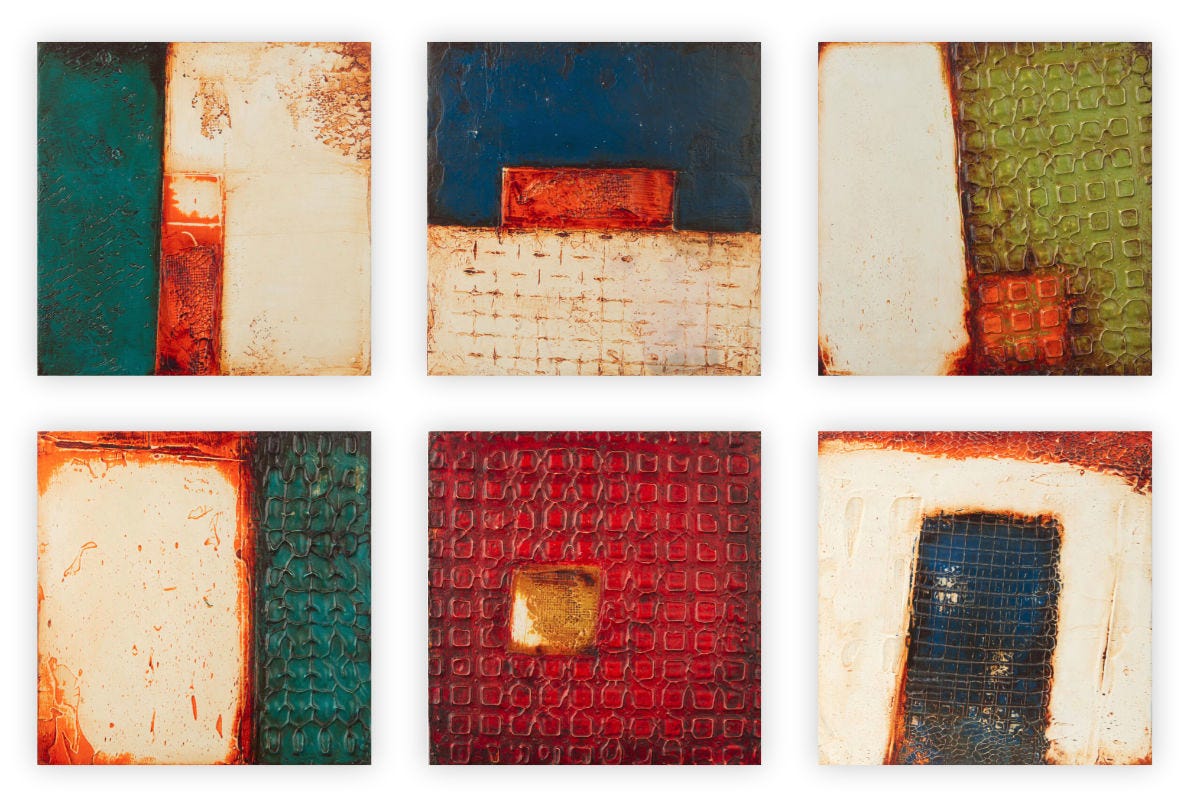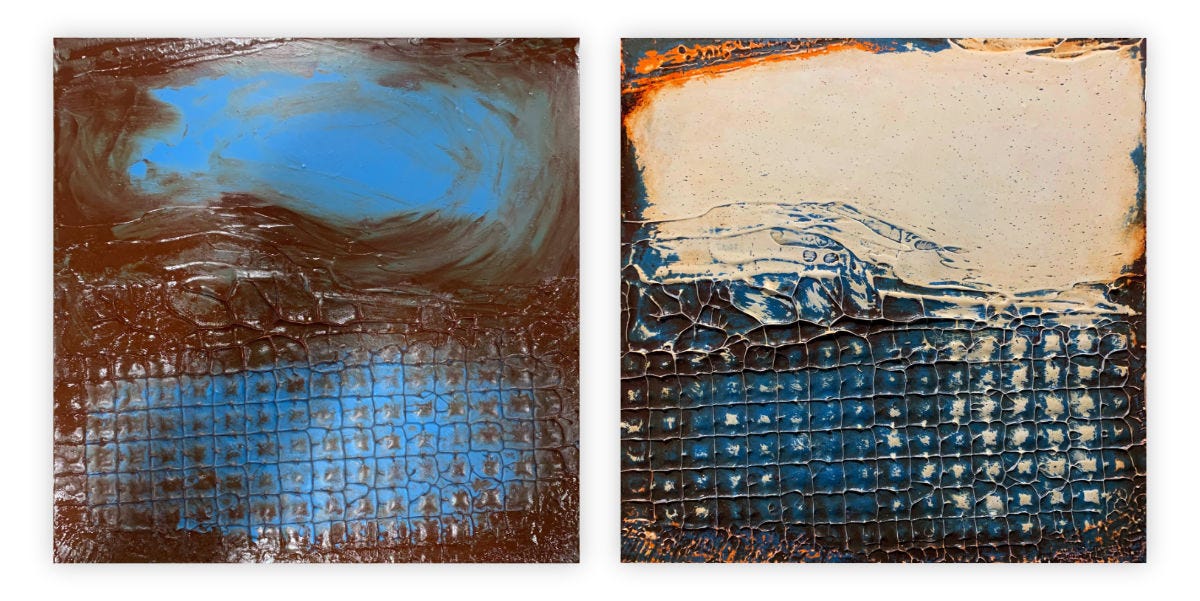A couple days ago I finished the last—at least for now—of a series of paintings I’ve been calling Cell Damage. I’ve posted a few of them on Instagram and over the past several days I’ve been doing an informal post mortem and really looking at them as a body of work to try to determine what worked, what didn’t, and why in each piece. I tend to think of my work in series, rather than as individual paintings, so when I finish a series—or at least get to a point that I want to take a break—I like to look at the whole thing and try to pick out a theme or a narrative or maybe just a technique that I’d like to take in a different direction. In that way, I think that all of my work is connected, though it may not be obvious at first.
Cell Damage is an evolution of a 36-piece series I did last year called Grid Variations, vol. 1, which was an attempt to take a break from the propaganda-based work that I was doing and instead simply explore texture and color bound to a grid. I love grids and, try as I might, it’s hard for me to get away from them, both in my design work and when I’m painting. I really enjoyed how it turned out and followed it up with Grid Variations, vol. 2, which was another 36-piece series, but I used a different color palette and heavier texture throughout. Just as with volume one, I really liked the results, especially the way that pieces from the two series could hang together and still look cohesive. Also, since all 72 pieces are the same physical size and are based on the same 2-inch grid, the individual paintings can be rotated and combined into nearly limitless options. I realized with Grid Variations that the work—at least in my eyes—was skewing into the realm of design and decor, which I actually kind of love. It feels like with decor, there’s more room to play and the work doesn’t have to be taken so seriously. Straddling the line between art and design is something I’ve found interesting for a long time. In fact, one of the ideas I’ve had around this latest work is to build a website where customers could purchase custom versions of the work from Grid Variations or Cell Damage in a variety of curated color palettes—or supply their own—that would match or complement the surroundings where they would be displayed. I still love the idea and it’s something I may actually end up doing.
After Grid Variations, I wanted to see how far I could push the texture before it became a caricature and create a bit of compositional tension by slightly skewing and playing with the scale of the grid that I had bound the previous work to. I used similar source materials for the textures throughout the series to see whether it would help provide cohesion or just end up feeling like a crutch. I ended up making them a few at a time and one of the things I found interesting was how much my opinion of some of them changed between the initial texture stage and how they looked after applying the main colors and then pushing and pulling the weathering and distressing in order to get to the final piece. And I think final should be in quotes here because there are a few that I still feel could use a bit more tweaking. But because each stage of my process is fairly permanent, changes are often tough to pull off, which is one of the reasons that I’ve been wanting to try encaustic or cold wax. With either of those materials, you can be much more surgical about making tweaks to specific areas of the piece without the risk of damaging or even destroying the whole thing.
Overall, I think the series turned out pretty well. If I’m being honest, I don’t love every piece and a couple of my least favorites are the pieces that have gotten the best feedback from Adrianne and the few other people who have seen them. And I think that’s okay. Part of the process—at least my process—is letting the happy accidents take the work where it wants to go. I can make choices around color and composition and I can bring purpose and intent and maybe even some skill to the work, but there are multiple steps along the way where it’s out of my control, to a lesser or greater degree. For example, if I’m trying to take down the color in a particular spot and I go at it too hard, I’m likely going to blow through that layer completely and maybe even the layer beneath it. It happens a lot and when it does, there’s no going back. Instead, I have to pivot and ask myself what I can do or what else I can do to bring that area back into cohesion with the rest of the piece. Sometimes it works and sometimes it doesn’t, but I think that’s one of the great things about making art. I don’t believe that I have to love everything I make equally because even if I don’t love it, someone else might—and this particular work isn’t being made just for me. As I said earlier, I think this work is more design and decor than art—at least art with a capital A—and because of that, I allow myself more flexibility not just around the making but also in my own appreciation of it, for lack of a better word. By contrast, in my narrative work, while there are still happy accidents and unforeseen consequences of the process I use, I feel like I bring a greater degree of clarity to what I expect from the end product.
Looking at this series and the previous two all at once definitely helps to provide some inspiration and direction for where I'd like to go next. I think I’ve done enough of these pieces now that I can put them out into the world and see where and how they land for an audience, both as art and as product. Pressing the pause button before it gets too familiar or stale also gives me the chance to bring some of the aspects of the work that I really like into future bodies of work, including the next volume of The New Propaganda—which is going to feature some terrific vintage ephemera—and a project that I’ve been researching and sketching out ideas for around former President John F. Kennedy.
If you’re a photographer, one of my standing recommendations and still one of the best photo books you can get in terms of seeing how iconic photographers worked a scene or subject to create a series or a body of work is Magnum Contact Sheets. The huge 11x14 inch first edition is out of print, but you can still find it used. Or you can pick up the reprinted version, which is a little smaller, but can be had for less than fifty dollars.
Another book I’d recommend and it’s one that I’ve recently come back to is nucollage.001 by David Carson. There’s only one edition, which is out of print, but it’s definitely worth picking up if you can find a used copy. I actually made a video review of it when it came out in 2019 and one of the things that I still love the most about it is that it’s a record of experimentation and play around creating an entirely new body of work. Carson started it on the floor of his garage and continued to create pieces in hotel rooms wherever he happened to be lecturing around the world using materials that he either found or sourced along the way. It’s fascinating to see how the work evolved and how it inspired commercial jobs like the incredible John Coltrane 1963: New Directions box set. In addition to my video review, there are a few flip-throughs of the book online and you can follow David on Instagram to see more.





